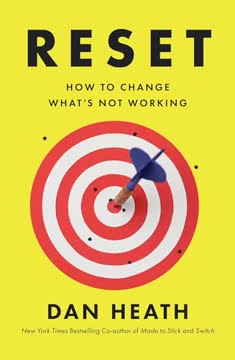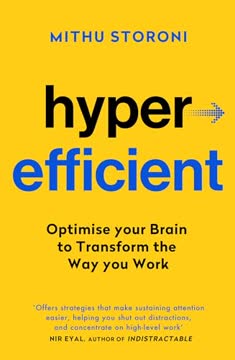Key Takeaways
1. The Old Efficiency Model is Obsolete for the AI Age
The old kind of factory-style continuous work creates the wrong kind of ecosystem in this new phase of the digital age.
Outdated paradigm. For over a century, the industrial age imposed a factory-style, assembly-line model on all forms of work, prioritizing quantity and continuous output over quality and nuanced thought. This linear approach, where human minds were mere cogs in a production machine, was suitable when work was monotonous and didn't demand complex thinking or exceptional creativity. However, this model is fundamentally misaligned with the demands of the modern digital age.
AI's transformative role. With the rise of artificial intelligence, machines now handle straightforward, lower-level thinking jobs more efficiently than humans. This shift redefines knowledge work, emphasizing idea generation, complex learning, and innovative problem-solving. A company's worth increasingly depends on intangible assets like algorithms and brand identity, which are realized through exceptional "brainwork" rather than mere production volume.
New definition of efficiency. The assembly-line-flattened mind, devoid of peaks of brilliance and troughs of recovery, cannot thrive in this new landscape. Efficiency is no longer about how much you produce, but how well. To succeed, we must abandon the continuous, linear work model and instead align our work patterns with the brain's inherent makeup, allowing for the rhythmic fluctuations necessary for genius ideas and ingenious solutions.
2. Your Brain is Wired for Rhythmic, Power-Law Working
Almost every account in Sahlins’s anthology tells of a rhythmic pattern of working, in which an intense burst of work is followed by periods of lighter work and rest.
Nature's rhythm. Our ancestors, like the Ju’/hoansi of Botswana, perceived time as a rhythmic cycle, with life's pace set by nature's predictable movements. Hunter-gatherer communities across diverse geographies instinctively adopted a power-law pattern of work: intense bursts of labor followed by longer periods of leisure and recovery. This innate propensity, observed in foraging patterns (Lévy walks) and even in the sleep cycles of newborn mammals, suggests our brains are naturally inclined towards this undulating rhythm.
Technology's distortion. The agricultural and industrial revolutions, and subsequently digital technology, flattened these natural fluctuations, imposing a linear, constant "technological time" that prioritizes continuous output. This artificial pace, from railroad timetables to modern office schedules, forces us to work against our biological wiring, leading to chronic mental strain.
The hyperefficient advantage. Embracing a power-law-like pattern—working intensely for short periods, punctuated by breaks and followed by rest—protects against mental strain and optimizes mental output. Even celebrated minds like Darwin, Freud, and Einstein exhibited this rhythmic pattern in their knowledge work. By aligning our work with our brain's inherent rhythms, we can achieve a "hyperefficient" mode that combines peak performance with sustainable well-being.
3. Master Your Brain's Three Mental Gears for Optimal Performance
In this way, your blue dot network expertly controls your brain’s configuration, changing your brain’s state simply by changing the way it fires.
The blue dot network. Deep within your brain, the locus coeruleus (your "blue dot") acts as a gear system, controlling your mental pace by firing norepinephrine. This intricate network shifts your brain into three main configurations, each with unique abilities, allowing you to adapt to different mental demands.
Understanding the gears:
- Gear 1 (Slow Mode): Ideal for rest, recovery, and daydreaming. Your attention is panoramic and fuzzy, allowing for spontaneous insights and a mental "slate cleaning."
- Gear 2 (Medium Mode): The sweet spot for mental work, concentration, learning, problem-solving, and creativity. Your prefrontal cortex is fully engaged, providing sharp, adaptable focus.
- Low-energy Gear 2: For spontaneous creativity, allowing attention to drift and then narrow on emerging insights.
- High-energy Gear 2: For complex learning, divergent thinking, and brainstorming, boosting lateral thinking and connections, often fueled by intrinsic motivation.
- Gear 3 (Fast Mode): For quick responses in critical moments. Crude mental abilities are enhanced (e.g., typing speed), but refined thought and judgment are compromised. Overuse leads to wear-and-tear and hampers decision-making.
Strategic gear shifting. Your brain naturally flickers between these states, but conscious control is key. Spending too long in Gear 3 causes strain, but Gear 2 can offset this damage. The goal is a power-law-like pattern: short bursts in Gear 3 (when necessary), balanced by longer periods in Gears 1 and 2, optimizing both efficiency and mental well-being.
4. Align Your Work with the Rhythms of the World and Body
Changing mental gears becomes easier if you can ride these ripples, much as a surfer rides an ocean’s waves.
Nature's clock. Our bodies are attuned to natural rhythms. A 24-hour biorhythm dictates norepinephrine levels, rising in the morning for alertness and falling at night for rest. A 12-hour cycle creates a "post-lunch dip" around midday, pulling us into a brief Gear 1 state. By aligning our work with these natural fluctuations, we can effortlessly tune our mental gears.
- Focused work (Gear 2): Best in late morning (9-1/2 pm) and late afternoon (3/4-8/10 pm).
- Creative work (low-energy Gear 2): Optimal in the morning upon waking (until 9/10 am) and in the evening (8/10 pm until bedtime).
Body-mind alliance. Physical movements and sensory inputs profoundly influence our mental state.
- Exercise: Moderate exercise raises your gear, boosting alertness and focus for up to two hours. Muscle contraction (e.g., squeezing a stress ball) can instantly increase alertness.
- Temperature: Gentle temperature shocks (hot/cold showers) can shift you into Gear 2.
- Breathing: Slow, prolonged exhalations (5-6 breaths/minute) stimulate the vagus nerve, actively shifting your brain into a Gear 2 pattern of firing, promoting "calm alertness."
- Gaze: Narrowing your gaze (Quiet Eye technique) enhances focus, while widening it fosters creativity. Detaching your gaze (closing eyes, walking) allows for mental rest and spontaneous insights.
Harnessing the environment. Light and sound also act as powerful gear-shifters. Red-hued light (sunrise/sunset) encourages calm, while blue light boosts alertness. High-frequency, loud sounds raise your gear, while soft, slow sounds lower it. White noise can help focus in distracting environments. By consciously manipulating these elements, we can create an ecosystem that naturally supports our desired mental state.
5. Fuel Your Mental Engine with Intrinsic Motivation and Learning Progress
When your motivation comes from within you, it tends to drive you toward intangible goals—for example, the desire to learn something, get better at something, or overcome a challenge.
The power of intrinsic drive. In the AI age, where work is an "obstacle course" of new skills and problems, intrinsic motivation is paramount. It's the inner desire to engage in an activity for its own sake—the "childlike pleasure of playing"—that turns your mental engine into a self-driving car, making work feel alive and effortless. This contrasts with extrinsic motivation (paychecks, status), which relies on external rewards and can induce psychological tension, pushing you into Gear 3.
Turning threats into challenges. Controllability is key to transforming extrinsic motivators from threats (which induce fear and Gear 3) into challenges (which foster a "play to win" mindset in Gear 2). Workplaces with blame cultures stifle creativity by forcing a loss-avoidance mindset. Fair, transparent competition, where effort is valued and self-worth protected, can be a powerful motivator.
The Learning Progress mechanism. Intrinsic motivation is reliably "switched on" by the sensation of making consistent, incremental progress in learning or skill-building. This mechanism, rooted in our innate drive to master the unknown, makes the world feel more controllable and deeply satisfying.
- Optimal difficulty: Learning progress is fastest when tasks are moderately difficult (around 15-20% error rate), stretching skills without overwhelming.
- Process over outcome: Focus on the journey of improvement, not just the finish line.
- Effort as reward: Consistently rewarding effort can create a "short circuit" where the act of trying hard becomes pleasurable in itself, generating its own intrinsic motivation.
By cultivating intrinsic motivation, we not only make work more enjoyable and sustainable but also prime our minds for the deep engagement required for learning and innovation.
6. Cultivate Flow States for Effortless Peak Performance
When you’re in a state of Flow, however, this push and pull seems to occur almost effortlessly.
The Flow phenomenon. Flow is a state of deep immersion where work feels effortless, time disappears, and performance peaks. Psychologist Mihaly Csikszentmihalyi observed that in Flow, you exert less effort yet achieve better results, as if your work replenishes rather than depletes your energy.
Conditions for Flow:
- Challenge: Pursuing something that stretches your existing skills.
- Clear goals: Knowing precisely how to approach the challenge.
- Skill match: The challenge is neither too easy nor too overwhelming.
- Immediate, clear feedback: Receiving real-time confirmation of success.
- Motivation: A strong desire to overcome the challenge repeatedly.
The steeplechase of effort and feedback. Flow emerges from a rhythmic cycle of tension and pleasure, where each challenge is met with effort, followed by immediate feedback (a "prize") that resolves the tension. This dynamic, like a steeplechase, creates a self-sustaining spin of engagement. Neuroscientifically, Flow is theorized to occur when the brain's attention and reward networks spontaneously synchronize, leading to increased efficiency and a boost of energy.
Applying Flow to knowledge work. Flow is a superpower for success in a rapidly changing world, making the act of stretching beyond your comfort zone inherently pleasurable. It can be engineered into various tasks:
- Software engineering: Segmenting code into challenges, running tests for immediate feedback.
- Creative work: Resolving conceptual challenges into tangible forms (e.g., a chapter, a design element).
- Learning: Online courses using adaptive difficulty and module-end tests.
- Gamification: Introducing challenges, badges, and real-time analytics to mundane tasks.
By structuring work to foster these conditions, workplaces can inspire intrinsic motivation and unlock the brain's capacity for sustained, high-quality output.
7. Adapt Your Learning Strategies to the Pace of Change
To keep up with the soaring technology curve, we will need to continuously upgrade skills and expand knowledge across our lifetime.
Learning in the unknown. The exponential pace of technological advancement means knowledge quickly becomes obsolete. We must continuously learn, often on the job, for a constantly changing "syllabus." The discomfort of encountering the unknown is a signal that your blue dot network is firing faster, releasing norepinephrine that optimizes your brain's capacity to learn. The key is to hover in a high-energy Gear 2 state, embracing uncertainty without toppling into Gear 3.
Strategies for different types of learning:
- Learning skills: Plunge into unfamiliar territory by starting with aspects that overlap with existing skills, making small changes, and incrementally expanding your knowledge. This builds confidence and proficiency faster than passive study.
- Learning information: Best done in Gear 2. Immediately after learning, briefly turn your attention inward (e.g., walking) to mitigate "eviction risk" and cement new knowledge. Later, stimulating activities (e.g., exciting videos, moderate exercise) can further enhance retention by boosting norepinephrine.
- Learning complex concepts: Requires agile maneuvering across Gear 2 states—deep focus, peripheral thought, and internal reflection. Walking can be particularly effective for gaining clarity on complex ideas.
The role of emotions and exercise. While intense emotions (Gear 3) create "flashbulb memories" of the context, they hinder thoughtful learning. Emotions can help learning if they "gild" information without pushing you out of Gear 2. Exercise, by increasing lactate and norepinephrine, supports learning, but its effects are nuanced: moderate intensity or short sprints can be beneficial, while over-exertion can lead to fatigue and suboptimal learning.
8. Engineer Your Environment for Creative Problem-Solving
Big ideas come from the unconscious. But your unconscious has to be well-informed, or your idea will be irrelevant.
The creative process. Creativity unfolds in stages: preparation (gathering information), incubation (subconscious processing), illumination (the "a-ha!" moment), and verification (refining the idea). This journey requires a mosaic of mental states, shifting between focused attention and expansive wandering.
Fostering insights:
- Spontaneous insights (low-energy Gear 2): Achieved when your mind is tranquil and relaxed, allowing attention to wander gently. Activities like walking, showering, or even boredom can facilitate this state, letting your subconscious incubate thoughts.
- Thinking outside the box (high-energy Gear 2): Your mind is sharper, faster, and more exploratory. A wider attentional beam helps you spot connections between disparate ideas (e.g., Murakami's umbrella machine, Wald's WWII plane analysis). Freedom from physical constraints and fear of judgment enhances divergent thinking.
The power of play. Creativity thrives in an environment of carefree experimentation, free from the pressure of deadlines or the fear of ridicule (Gear 3). Play, driven by intrinsic motivation and often inducing flow, provides the perfect backdrop for novel ideas to germinate. Even brief, unrelated activities, like Einstein playing the piano, can trigger insights by dissipating pressure.
Ecosystems for innovation. Institutions like Bell Labs exemplified an optimal "greenhouse" model for creativity: private offices for focus, long corridors for serendipitous encounters, common spaces for cross-pollination, and freedom from short-term deadlines. This model prioritizes meaning, agency, and creative freedom, allowing ideas to grow organically. For dynamic problem-solving, cultivating intrinsic motivation helps sustain mental stamina, enabling fluid reasoning and adaptability to constantly shifting goals.
9. Lighten the Cognitive Load in an Information-Saturated World
Your entire cognitive machinery grinds to a halt if your working memory gets overwhelmed.
The information deluge. The digital age has made information transfer instantaneous and virtually free, leading to an unprecedented volume of data. This creates three problems: high information volume, low information quality, and insufficient attention to cope. Our working memory, a temporary scratchpad, has limited capacity and can easily be overwhelmed, impairing attention, learning, and problem-solving.
Strategies to lighten the load:
- Remove redundancy: Organize information to minimize processing effort (e.g., integrating text and visuals, writing notes instead of memorizing).
- Thin out traffic: Distribute information across different mediums (e.g., listening to audiobooks while reading, using physical controls alongside digital displays).
- Add texture and variety: Connect new information to existing knowledge by presenting it in varied, context-rich forms (e.g., stories instead of bare facts).
- Loosen the goal: Frame tasks with less rigid goals to free up working memory for processing information rather than constantly comparing progress to an endpoint.
Sifting signal from noise. The ease of communication often leads to low-quality, verbose information, forcing us to sift through irrelevance. "Media richness theory" suggests using richer communication channels (like face-to-face) for complex messages to reduce ambiguity and mental effort. Brevity, paradoxically, can be more mentally taxing if it strips away context, demanding "abbreviated thinking" that drains resources.
10. Reclaim Your Time and Attention from Digital Urgency
The more urgent information seems, the more compelled you feel to process it quickly. Urgency demands speed.
The illusion of urgency. Modern technology transmits information at speeds beyond human perception, creating a constant sense of urgency. "Breaking news" and "urgent" emails, regardless of actual importance, push our brains into Gear 3, where we struggle to digest information and make thoughtful decisions. This "inflation" of urgency leads to a permanent state of vigilance and anxiety, hindering focused work.
The problem with brevity and deadlines. While short messages seem efficient, extreme brevity often makes information harder to grasp, demanding more mental effort to decipher meaning. Similarly, frequent deadlines, a relic of assembly-line thinking, impose a false equivalence between objective time and the brain's fluctuating pace, endangering creativity and leading to rushed, biased decisions. Bell Labs' success, for instance, was partly due to freedom from strict deadlines.
Managing continuous attention. The digital age demands continuous attention, whether actively batting away problems or passively monitoring intelligent machines. Both are tiring.
- Active work: Performance can sink in as little as five minutes; proactive micro-pauses (5 seconds every few minutes) can sustain it.
- Passive vigilance: Performance slides in 20-30 minutes due to boredom and lack of intrinsic motivation. Short, frequent breaks (3-10 minutes) are crucial. Actively introducing feedback and goals (e.g., "self-checkups" on goals, brain-monitoring tech) can combat drudgery and improve focus.
To counter these challenges, we must deliberately slow down, prioritize quality over speed, and consciously manage our attention and mental gears.
11. Build Resilience to Uncertainty Through Deliberate Practice
If we eliminate uncertainty altogether, we forget how to cope with it at all.
The paradox of control. As software replaces hardware, we gain influence but lose direct control, making the world feel increasingly uncertain. Technology, while eliminating some uncertainties, introduces new, complex ones (e.g., algorithmic trading at the fifth decimal point) that overwhelm human scale and have unknowable consequences. Eliminating all uncertainty can make us weaker, as seen in the downfall of Angkor, which became fragile after taming its water supply.
Embrace "Chaos Monkey." To build resilience, we must deliberately introduce controlled chaos into our systems. Netflix's "Chaos Monkey" tool, which simulates system failures, ensures teams are always prepared for worst-case scenarios. This regular exposure to volatility, like a "fire drill," prevents panic during actual crises and keeps skills sharp, ultimately lowering baseline anxiety.
Training self-control. A powerful way to cope with uncertainty is to train self-control, allowing you to remain calm and in Gear 2 during high-stakes situations. Elite athletes and military special forces (e.g., Jeb Corliss, Navy SEALs) repeatedly expose themselves to terrifying scenarios to master their emotional responses and maintain focus. This training, ideally pursued through hobbies or pastimes, builds mental robustness.
The power of rituals. Superstitions and rituals can act as psychological "uncertainty reducers." By delegating uncontrollable worries to unseen forces or by consistently performing a series of actions before a high-pressure event (like Rafael Nadal's serve ritual), we create an illusion of control. This consistency reduces anxiety, frees up mental resources, and helps maintain focus, even if the ritual itself doesn't magically alter the outcome.
Last updated:
Review Summary
Hyperefficient receives mixed reviews, with an average rating of 3.66 out of 5. Positive reviews praise its insights into brain mechanics, productivity strategies, and cognitive gears. Readers appreciate the practical advice for optimizing work habits and enhancing creativity. Critics find the content repetitive, obvious, or lacking depth. Some reviewers note the book's deep technical discussions, while others feel it could have been condensed. Overall, readers value the book's exploration of aligning work with natural brain rhythms, though opinions vary on its effectiveness and originality.
Similar Books










Download PDF
Download EPUB
.epub digital book format is ideal for reading ebooks on phones, tablets, and e-readers.





